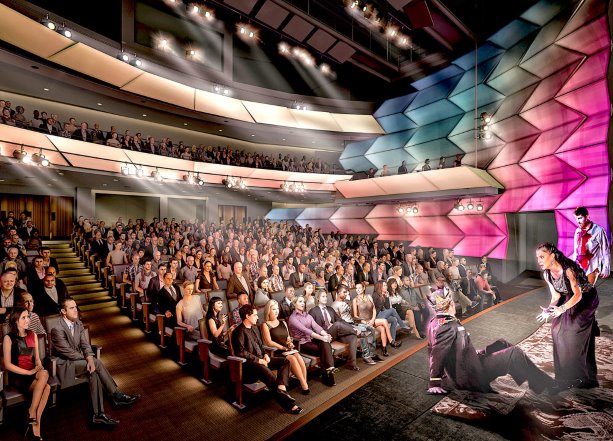It isn’t every day that a construction company is tasked with converting a large theatre into two smaller venues, while working around unmapped ducts, pipes and wires.
But that was the challenge faced by Toronto’s Gillam Group Inc. on the recently completed $8-million renovation at the Toronto Centre for the Arts.
The centre, which opened in 1993, originally housed three theatres, including the mammoth 1,700-seat main stage theatre, which was home to mega-musicals.
Faced with difficulties attracting enough tenants to occupy that space after the 2010 closing of the musical Jersey Boys, the centre opted to undertake an ambitious renovation that strategically split the main stage in two.
The new 296-seat Greenwin Theatre was built on the stage and backstage areas. The remainder of the house became the Lyric Theatre, which seats 550.
"When we saw the request for proposals, we knew there were going to be some substantial challenges inherent in the project," recalls Gillam Group president Marcus Gillam.
"But these are the types of projects that get us excited and out of bed in the morning."
The firm was retained as construction manager for pre-construction services in September 2014. It became the constructor in January 2015 on the project, overseen by Diamond Schmitt Architects.
As part of its scope, Gillam Group provided "design-assist" services.
On site were project manager Benjamin Valliquette, who joined the Gillam Group in April 2013, and senior project superintendent Andy Gee.
"The heavy lifting was done mainly by our on-site and in-house estimating teams," Gillam says.
Construction got underway on the Phase 1 Greenwin Theatre in January 2015 and on the Phase 2 Lyric Theatre in September 2015.
One of the key challenges was erecting a new structural support system "with very complex geometry" for the new LED chevron panels, rigging system and theatrical catwalks.
"The new structural supports needed to penetrate a massive domed ceiling only supported by Unistrut and aircraft cable," Valliquette says.
"Hidden within and beyond all the layers of existing walls and ceilings were clashes and interferences just waiting to happen, all potentially in the way of the new structure and all unmapped."
In order to properly design and build the new structure to avoid such interferences, the Gillam Group joined forces with George Brown College, Valliquette’s alma mater, to undertake a scan of the existing building and also create a digital model.
In terms of the Greenwin Theatre, the biggest challenge was time, Valliquette says.
"The theatre had a sold out show moving in, in April," he says. "We had absolutely no flexibility when it came to the opening date.
"This literally gave us less than three months to construct Phase 1 and with a number of custom items coming from overseas, this was no simple task."
A case in point, he says, is the theatre’s seating system. The theatre was designed as well to be a video studio, which meant the seating system had to be retractable to provide a completely open floor space.
Gillam Group was able to procure an electronic, telescopic seating system that when extended could seat upwards of 250 patrons.
This unit was fabricated in Slovakia and shipped from Russia "in the dead of winter," Valliquette says.
Another major challenge, in the case of both theatres, entailed co-ordination of all the various components that allow the theatre to function.
"Theatres are a whole new world when it comes to design co-ordination," Valliquette says. "You see things that you just don’t see on other buildings.
"It’s incredible how much stuff actually goes into these performance venues. The co-ordination of all this stuff really takes a lot of foresight. Factors such as sightlines, acoustics and lighting are critical to the success of the venue. It’s important to have a team of trades that gets that."
The project was carried out by a "dream team" of trade contractors which included Darlington Steel (structural steel and architectural metals), Everbrite Industries (electrical and lighting) and Eventscape (chevron panels).
The Greenwin Theatre was substantially completed on April 20, 2015. The Lyric Theatre was substantially completed Sept. 14 of this year.
"We were extremely fortunate to have an amazing client and design team that understood the creative and collaborative work culture needed for a complex project like this," Valliquette says.
The Diamond Schmitt team was headed up by associate Antra Roze, who has worked on such projects as the Harman Center for the Arts in Washington, D.C. and the Max M. Fisher Music Center in Detroit.
The firm was retained by the Toronto Centre for the Arts in early 2014.
"I’d say the biggest challenge (from a design perspective) was the acoustics separation," Roze says. "We had to make sure that when there was a performance in one theatre, you didn’t hear it in the other."
She says carving an existing theatre into two venues is "definitely more challenging" than designing such a facility from scratch.
"Every step of the way you are hitting something challenging," she says. "But we put our heads together and were able to find ways of making this work."






Recent Comments
comments for this post are closed